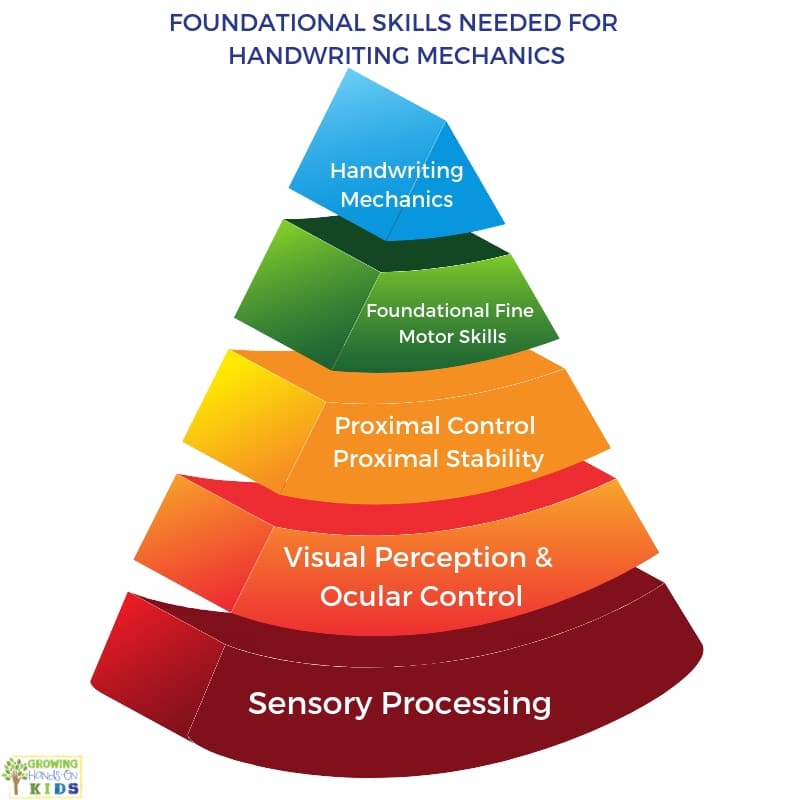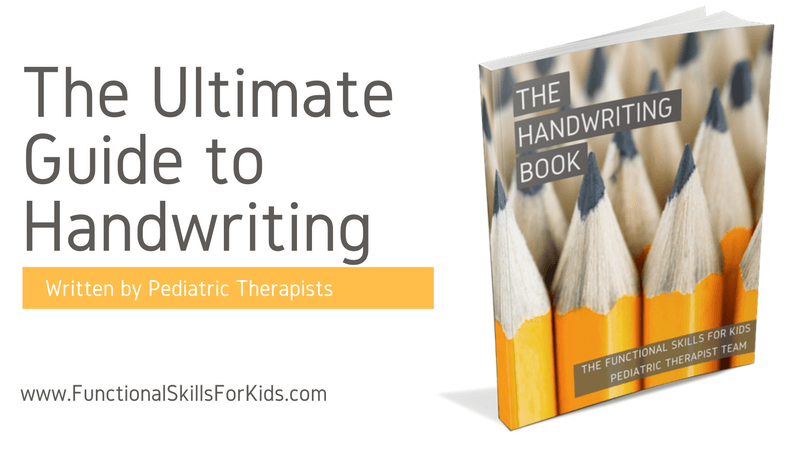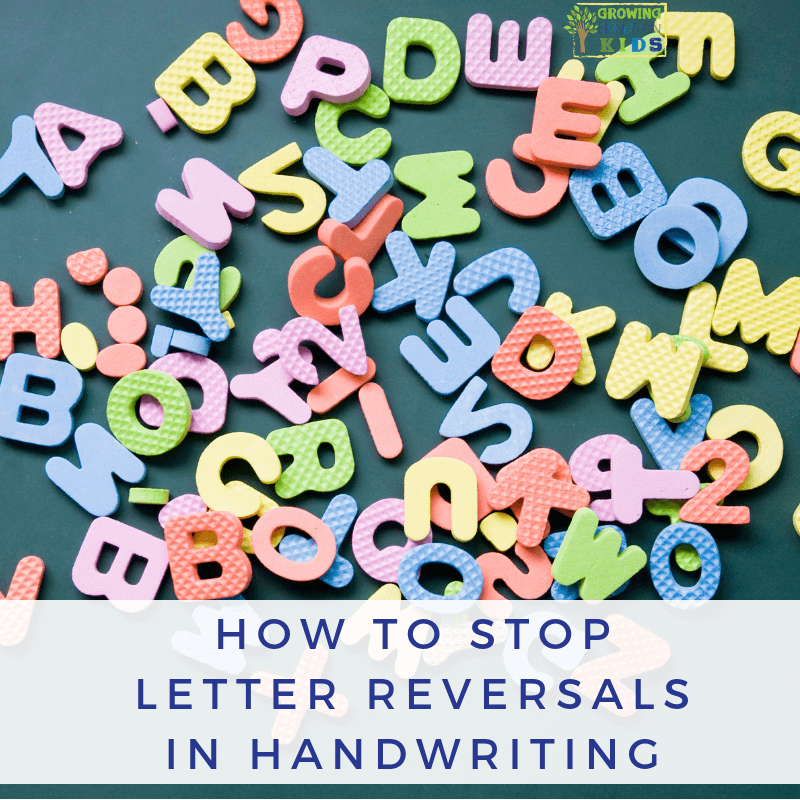The Foundational Skills Needed for Handwriting Mechanics
Affiliate and Referral links are used below to promote products I love and recommend. I receive a commission on any purchases made through these links. Please see my disclosure policy for more details. As an Amazon Associate, I earn from qualifying purchases.
You probably think of handwriting mechanics as the act of picking up a pencil and writing on paper. And while that is true, there are some important skills that need to be in place for a child to be successful with this. Let's take a look at the foundational skills needed for handwriting mechanics.
Foundational Skills Needed for Handwriting Mechanics
Does the graph above surprise you at all? If you are familiar with the pyramid of learning and the central nervous system by Taylor & Trott (1991), then this graph seems similar.
Before we can expect our children to master handwriting mechanics (or pencil grasp), we need to build these foundational skills to set them up for success. This doesn't mean your child won't have struggles with handwriting mechanics if you address these areas, but it will give them the tools they need to work around these struggles.
You can read more about the typical development of pencil grasps here.
Sensory Processing And Handwriting Mechanics
Sensory processing is the first to develop at birth. As a baby explores its environment, it learns to react to incoming sensory input. Children who struggle with sensory processing will struggle with other areas of development including poor reactions, attention, and poor body awareness.
The three sensory systems primarily responsible for these is the vestibular system, proprioceptive system, and the tactile system (or touch).
These three systems are responsible for how a child will hold a pencil later on, eye-hand coordination, writing on the lines, coloring between the lines, depth perception, bilateral coordination skills needed for holding the paper and writing with a pencil, using scissors, or using a dominant hand with writing, motor planning for new task, and attention to task.
To learn more about sensory processing, you can sign up for my 9-day sensory processing email series here.
Visual Perception & Ocular Control And Handwriting Mechanics
Sensory processing and visual perception are closely related through the three systems I mentioned above.
Visual perception is the process of the brain taking in and organizing the information we get through our eyes. When a baby is learning to pull its head up and begins to roll or crawl, it is also developing its visual perception skills.
Visual perception is also made up of various sub-skills. These include:
- eye-hand coordination (using the eyes and hands together to complete a task)
- visual discrimination (the ability to classify objects or shapes based on their color, shape, size, or position)
- position in space (the ability to process information about where you are in relation to things around you)
- figure-ground (seeing an object or form when it is in a complex background)
- visual closure (ability to process information when the object or word is hidden and decode it)
- form consistency (identifying objects, shapes, letters, numbers, or symbols when you see them in different ways)
- visual memory (being able to recall information about objects, shapes, symbols, or movements in your short term memory)
- visual sequential memory (the ability to recall and remember a sequence)
Ocular control refers to the ability to control the position and movement of the eyes in order to focus on an image or object. This is especially important for handwriting so that the student can visually focus on their handwriting and also copy from the board or a book.
Proximal Control and Proximal Stability and Handwriting Mechanics
Before we talk about proximal control and stability, we need to define proximal, a therapy term.
Proximal refers to the muscle groups closest to the middle or center of the body. So when we talk about proximal control and proximal stability, we are referring to the core strength (or control and stability) needed for different tasks.
When it comes to handwriting, children need the core control and stability to sit up straight and not slouch, arm and shoulder control as they move the pencil, and neck control to hold their head up straight.
If a child struggles with any of these gross motor areas, handwriting may be a struggle because they lack the core control and stability they need to perfect smaller movements such as handwriting.
Here is a great post on proximal stability from my friends at The Inspired Treehouse (pediatric Occupational Therapist and Physical Therapist).
Proximal control and stability are dependent on visual perception to tell them where their body is in relation to things around them. And it is also depending on the sensory processing system which also supports body awareness. All of these systems need to work together in order for fine motor skills to be perfected for handwriting.
Foundational Fine Motor Skills and Handwriting Mechanics
Most of us probably think of fine motor skills when we think about the areas of development needed for handwriting. But as we have seen, we need all the systems above to be working properly for fine motor skills to develop functionally for handwriting and other every-day life skills.
There are specific fine motor skills that help with handwriting so let's take a look at those briefly.
- bilateral skills (this is very depending on overall bilateral coordination skills that include gross motor)
- wrist stability and extension (functional positioning during handwriting includes the hand resting on the table with the wrist slightly bent back, or extended, while the fingers move the pencil for writing).
- hand strength (this is important for pencil grasp development)
- palmar arches (this is the inside of your hand where it bends and wrinkles and is needed for a functional grasp)
- thumb opposition (touching the tips of the thumb to each fingertip and is important for grasping a pencil and leaving an open web space between the thumb and index finger where the pencil lays while writing)
- in-hand manipulation (the ability to move objects within the hand using precise finger movements)
- separation of two sides of the hand (the ability to move your thumb and index finger while the 4th and 5th fingers are used to stabilize)
You can read more about the fine motor skills needed for handwriting in my blog post here.
More Resources for Handwriting
If you have a student who is struggling with handwriting or you just want to educate yourself more on the skills needed for handwriting, I highly recommend The Handwriting Book. Written by 10 pediatric Occupational and Physical Therapists (include me!), it will give you the tips, tools, and strategies you need to support handwriting skills and help struggling writers.
You May Also Like:
- How to Stop Letter Reversals in Handwriting
- 15 Hands-On Activities to Promote Pincer Grasp
- DIY Handwriting Toolkit
- Fine Motor Skills Checklist for Ages 0-6

Heather Greutman, COTA
Heather Greutman is a Certified Occupational Therapy Assistant with experience in school-based OT services for preschool through high school. She uses her background to share child development tips, tools, and strategies for parents, educators, and therapists. She is the author of many ebooks including The Basics of Fine Motor Skills, and Basics of Pre-Writing Skills, and co-author of Sensory Processing Explained: A Handbook for Parents and Educators.



